Making Arrowheads:
The Art of Flint Knapping
A Basic Overview
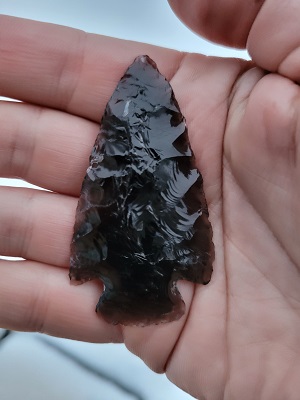
By Jason Knight
Flint knapping is the age-old art of making arrowheads and other edged stone tools. Hunter-gatherers relied upon this key wilderness survival skill to create important tools and hunting implements. Many people continue to practice the skill today, including traditional bowyers, experimental archaeologists, and primitive skills enthusiasts. You can also use these stone shaping concepts to make a functional stone blade for survival emergencies.
At its most basic level, flint knapping consists of: breaking open a piece of rock or stone (the stone/rock is also called a "core", or your "parent material"); then striking thin flakes of stone off of that core (using a technique called "percussion flaking"); and then shaping those thin stone flakes into the intended tool (often with a technique called "pressure flaking").
In general, the process of making arrowheads includes the following primary concepts:
- Safety and Ethics
- Choosing the Proper Materials
- Percussion Flaking
- Pressure Flaking
- Notching
1. Safety & Ethics of Making Arrowheads
Because flint knapping includes breaking apart rocks with force, where sharp flakes can fly off in any direction, it is very important to wear safety glasses. Gloves, shoes, and sturdy pants are also highly recommended. It is also important to flint-knap in a place where you can easily catch the sharp flakes that will fall to the ground (so that they are not accidentally stepped-on). You can put down a tarp or sweep up afterwards. Also, use a well-ventilated area, so not to breathe the dust created by breaking rocks.
When it comes to the ethics of flint knapping, the primary concern is to be mindful of the archaeological record. To an archaeologist, piles of flaked stone (debitage) can indicate the presence of an ancient village or camp. To prevent your work from being confused as archaeological evidence, always put your debitage in the garbage. Also be sure to sign and date your completed work with a diamond-tipped pen.
2. Choosing the Proper Materials
The best stones for making arrowheads include flint, chert, obsidian, jasper, quartzite and other stones that are somewhat brittle and have a fine-grained, uniform texture that is free of cracks, fissures, and fractures. Glass and porcelain can also be used. You can tap a stone to hear the pitch the tapping makes. Stones that produce a higher pitch when tapped are generally better for knapping.
To break apart and shape your material you will be using some simple tools for percussion and pressure flaking. These tools can be made out of antler parts, soft metal, soft stone, bone, or very hard wood. The best pressure flaking tools are made with an antler tip or copper tip.
3. Percussion Flaking
Percussion flaking is the act of striking your material to break it apart in a controlled manner. In a uniform material, the force from a strike moves out from the point of impact in a cone shape that is roughly 100 degrees wide. This is called a Hertzian Cone (see figure 1). Understanding this concept of how forces move through stone allows you to angle your stone to break it apart in an intentional way.
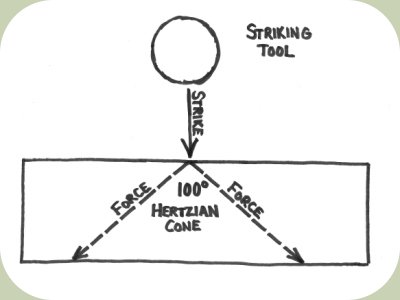 Figure 1
Figure 1
If your rock/stone/parent material (also called a core) is rounded, the first step is to break it apart so that you have angular edges to work with. This can be done by using a large striking tool (such as another rock, antler parts, a metal hammer, or hard wood). The goal is to create edges that are less than 90 degrees, which we call platforms (see figure 2).
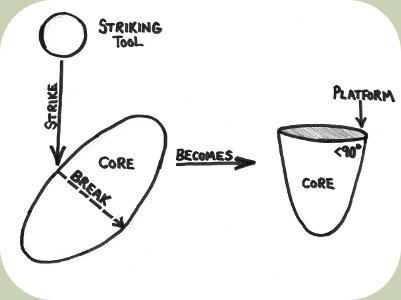 Figure 2
Figure 2
The next step is to strike thin stone flakes off of your core using smaller striking tools. It is these flakes that you will be further shaping into implements such as arrowheads or knife blades (see figure 3).
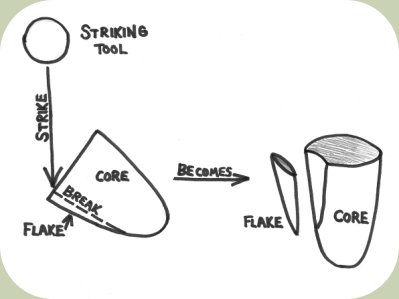 Figure 3
Figure 3Be More Prepared For Your Next Outdoor Adventure!

Don't leave without knowing these six essential survival skills. Our free survival mini guide reveals the strategies of:
- Shelter & fire to prevent the number one cause of death
- Obtaining clean water to avoid life-threatening dehydration
- Common wild survival foods and other critical skills!

4. Pressure Flaking
Pressure flaking is the act of using a pressure flaking tool (such as an antler tip or copper nail) to press hard against an edge of a stone flake, loading significant pressure, and then pulling the tool so that a smaller thinning flake pops off the larger flake (see figure 4). Pressure flaking allows a flake to be carefully shaped down into the finished arrowhead or other edged implement like a knife blade.
To remove long flakes with pressure flaking, a flake's edge often needs to be strengthened by abrading it to remove thin weak pieces. A spot on the stone flake's edge (a platform) is then picked out. Look for a point on the flake's edge that sits below the cross-section centerline of your flake. Then the pressure flaking tool is pushed onto the platform with significant force and a small thin flake is popped off of the piece (see figure 4). Repeat the process along the edges of the flake.
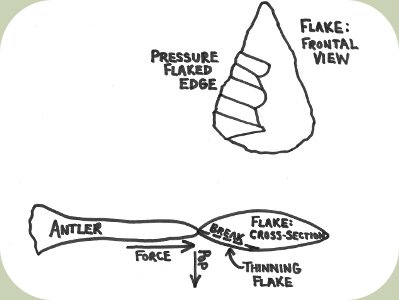 Figure 4
Figure 45. Notching
Notching is the final step in making arrowheads. Notching is the act of making deep indentations at the base of the flake (called notches) that allow you to attached the arrowhead onto an arrow shaft. The notches are made using more pressure flaking to remove material at the base of the point that allow the arrowhead to be bound to an arrow shaft (see figure 5).
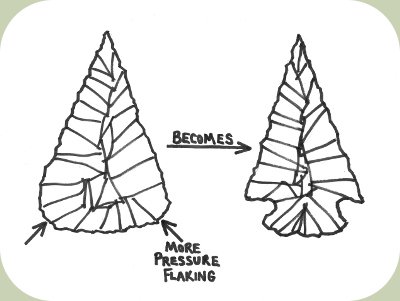 Figure 5
Figure 5
You now have a completed arrowhead! You can also use these same principles to make stone knife blades, axe heads, and other edged tools. Happy knapping!
By the way, if you enjoyed this article then you'll love our survival mini guide. You'll discover six key strategies to staying alive in the outdoors plus often-overlooked survival tips. We're currently giving away free copies here.
Additional Resources:
Go beyond the basics with our intermediate knapping article, Flint Knapping Arrowheads that includes step-by-step photographs and additional details.
A great material to start working with is beer bottle bottoms. It allows you to practice and learn the concepts before spending money on expensive stones. Here is a great article on making arrowheads from beer bottles.
Making arrowheads and other stone tools is taught as part of our Flintknapping Course where you can go far beyond the basics covered in our articles.
For detailed information on flintknapping, we recommend the book:
The Art of Flint Knapping by D. C. Waldorf.

About the Author: Jason Knight is a cofounder of Alderleaf Wilderness College and the author of The Essential Skills of Wilderness Survival. He has been teaching wilderness skills for over twenty-five years. Learn more about Jason Knight.
Return from Making Arrowheads to Wilderness Survival Articles
Is The Essential Wilderness Survival Skills Course Right for You? Take the "Online Survival Training Readiness" Quiz
See for yourself if this eye-opening course is a good fit for you. It takes just a few minutes! Get your Survival Training Readiness Score Now!

Grow Your Outdoor Skills! Get monthly updates on new wilderness skills, upcoming courses, and special opportunities. Join the free Alderleaf eNews and as a welcome gift you'll get a copy of our Mini Survival Guide.

 The Six Keys to Survival: Get a free copy of our survival mini-guide and monthly tips!
The Six Keys to Survival: Get a free copy of our survival mini-guide and monthly tips!
Learn more